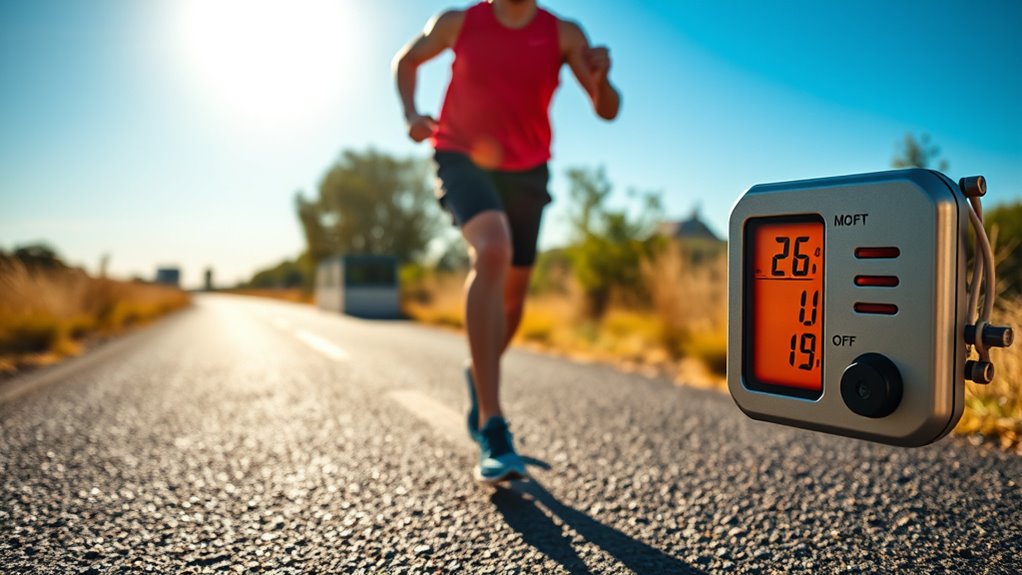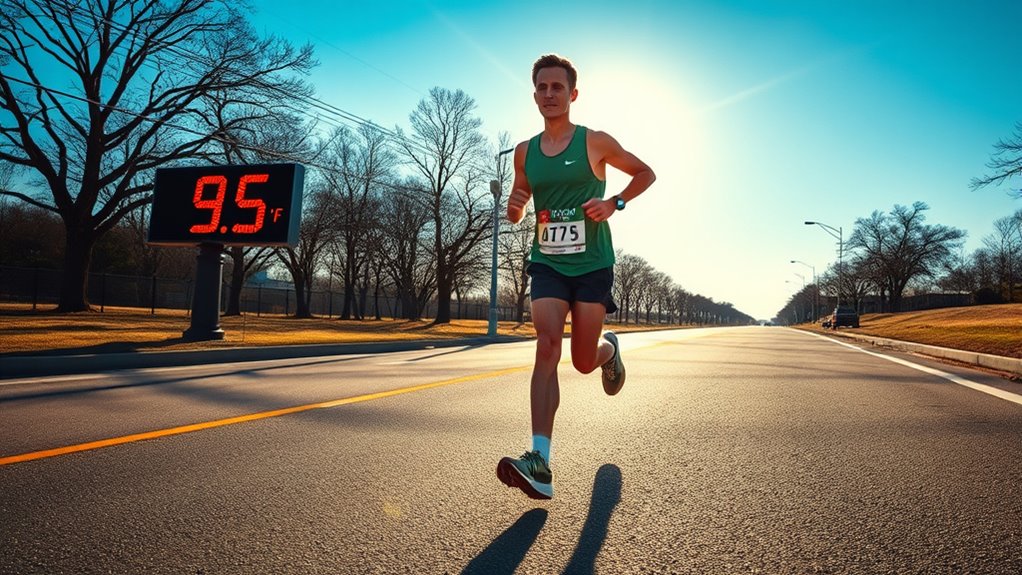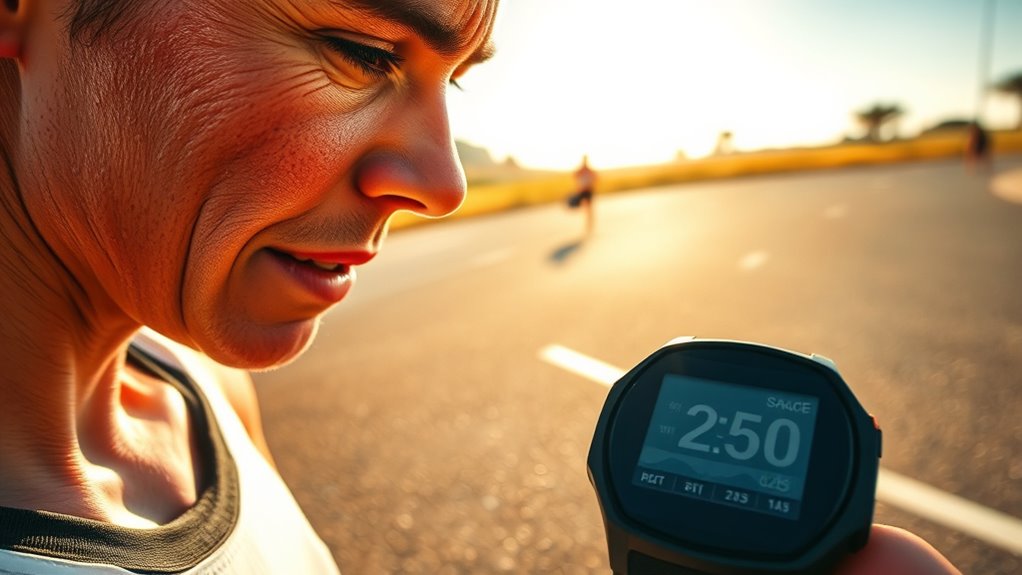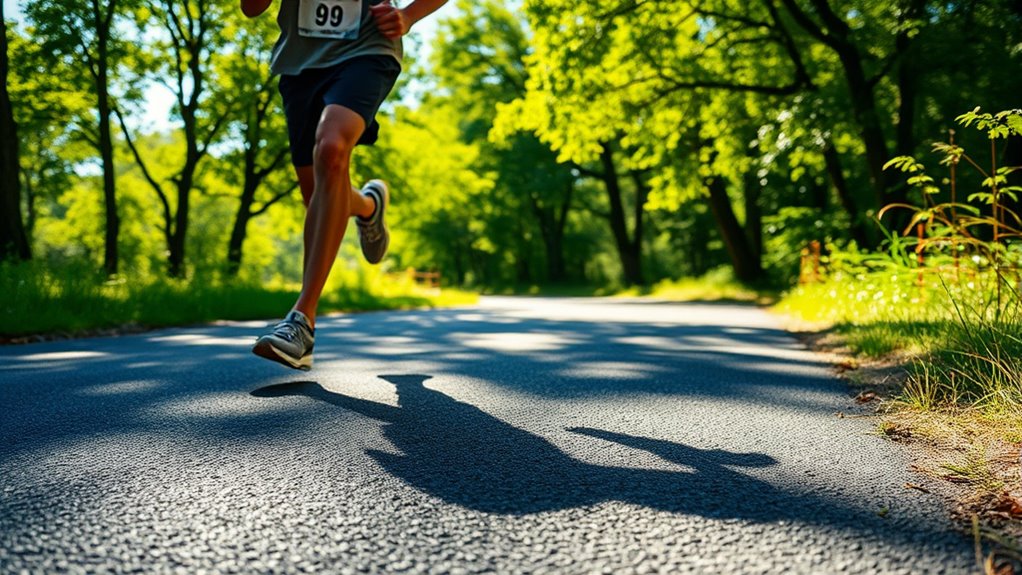When temperatures rise, your running pace typically slows down because your body works harder to regulate heat, causing increased fatigue and reduced performance. The heat-adjustment formula considers factors like temperature and environmental conditions to help you estimate how much your pace might decrease. By understanding these impacts, you can better plan your runs and stay safe. Stick around to learn how this formula can help you optimize your performance in hot weather.
Key Takeaways
- Higher temperatures impair heat regulation, leading runners to slow down to prevent overheating.
- The heat-adjustment formula predicts pace changes based on environmental temperature and physiological responses.
- Elevated heat increases sweat and heart rate, affecting endurance and overall running speed.
- Humidity and wind influence heat stress, requiring adjustments in pace and hydration strategies.
- Using the formula helps runners optimize performance and prevent heat-related fatigue during races.
Understanding How Temperature Affects Running Performance

Temperature substantially impacts your running performance by influencing your body’s ability to regulate heat and stay cool. When it’s hot, your body needs effective hydration strategies to prevent dehydration and overheating. Drinking water regularly and using electrolyte drinks help maintain fluid balance and boost endurance. Gear selection is also essential; lightweight, moisture-wicking clothing helps sweat evaporate and keeps you cooler. Wearing a hat or sunglasses can shield you from direct sunlight, reducing heat absorption. Incorporating climate control strategies can further optimize your performance in varying temperatures. Proper hydration is crucial, especially in high temperatures, to prevent heat exhaustion and maintain stamina. Conversely, in colder weather, layering properly prevents chills and muscle stiffness. By adjusting your hydration strategies and choosing appropriate gear, you can better manage temperature effects on your body, ensuring peak performance and reducing the risk of heat-related stress or cold-induced fatigue. Recognizing early signs of fatigue or dehydration allows you to adapt your efforts and stay safe during varying weather conditions.
The Science Behind the Heat-Adjustment Formula

You’ll see how temperature impacts your running speed and why your body responds differently in the heat. Understanding these physiological changes helps explain how we create the heat-adjustment formula. Plus, we’ll explore mathematical techniques that fine-tune your pace adjustments for ideal performance. Additionally, insights from AI-driven data analysis enhance the accuracy of these adjustments, ensuring safer and more effective training in varying temperatures. Recognizing the importance of angel numbers can also provide motivational guidance and reassurance during your training journey. Moreover, maintaining regular health check-ups can help identify underlying conditions that may affect your body’s response to heat, leading to more personalized and effective training strategies. Considering arcade game mechanics, such as high score systems and hardware performance, can provide a broader understanding of system responses under different conditions.
Temperature’s Effect on Speed
As the heat rises, your running speed naturally slows down due to the body’s effort to regulate temperature and prevent overheating. Humidity effects make this worse, trapping heat and reducing sweat evaporation, which hampers cooling. Wind considerations can help or hinder; a gentle breeze might cool you, but strong winds add resistance, slowing you further. Your muscles work harder to stay cool, draining energy and decreasing pace. To visualize this, consider the following:
| Condition | Impact on Speed | Emotional Effect |
|---|---|---|
| High humidity | Slows pace, causes fatigue | Frustration, exhaustion |
| Calm, still air | Overheating risk, slower pace | Anxiety, discomfort |
| Light breeze | Slight cooling, maintains speed | Comfort, relief |
| Strong wind | Resistance, reduces speed | Frustration, fatigue |
| Overcast skies | Cooler temps, faster pace | Optimism, motivation |
Physiological Response to Heat
When the heat increases, your body springs into action to maintain a safe core temperature, activating a complex physiological response. First, your sweat response kicks in, producing sweat to cool your skin as it evaporates. Second, your blood vessels dilate, increasing blood flow to the skin and aiding heat dissipation. Third, your heart rate rises to circulate blood more efficiently, supporting cooling processes. Fourth, you must adopt hydration strategies—drinking fluids regularly to replace lost electrolytes and prevent dehydration. These responses work together to regulate body temperature, but they also impact your pace. Proper hydration enhances your body’s ability to sweat effectively, helping you sustain performance even in high temperatures. Understanding these physiological responses is key to adjusting your pace safely in the heat.
Mathematical Adjustment Techniques
To accurately adjust your pace for different temperatures, you need a reliable mathematical model that accounts for heat-related performance changes. Mathematical adjustment techniques analyze pace variability caused by thermal adaptation, helping you modify your pace based on environmental conditions. These models often use formulas that incorporate temperature data, physiological responses, and performance patterns, allowing for precise predictions. By applying such techniques, you can predict how heat impacts your speed and make real-time adjustments. This approach minimizes the effects of heat stress, ensuring consistent performance regardless of temperature fluctuations. Understanding these mathematical tools empowers you to fine-tune your training and racing strategies, maintaining suitable pace while managing heat-related challenges effectively. Additionally, incorporating sound design principles can enhance training programs through immersive audio cues that simulate environmental stressors, improving heat acclimatization awareness.
Factors Influencing Pace Changes in Hot Weather

Hot weather can profoundly impact your running pace, with factors like temperature, humidity, and wind playing crucial roles. These elements influence how your body reacts and adapts during your run. To manage pace changes effectively, consider:
- Adjusting hydration strategies to prevent dehydration and maintain performance.
- Selecting appropriate footwear choices that promote breathability and reduce heat buildup.
- Timing your runs to cooler parts of the day, minimizing heat stress.
- Paying attention to humidity, as high levels can hinder cooling and slow you down.
Calculating Your Adjusted Pace Using the Formula

Understanding how heat affects your running pace is the first step toward maintaining performance in hot conditions. To calculate your adjusted pace, start with your baseline pace and apply the heat‑adjustment formula, which considers temperature and humidity. Proper hydration strategies are vital; staying well-hydrated helps your body regulate temperature and can slightly improve your adjusted pace. Gear selection also plays a role—wear lightweight, breathable clothing to reduce heat stress. Once you gather your environmental data and your baseline pace, plug these into the formula to find your adjusted pace. This calculation provides a realistic target for hot conditions, helping you stay consistent and safe during your runs. Keep your hydration and gear choices in mind to optimize your performance based on this calculated pace.
Applying the Heat-Adjustment Formula to Training Plans

Incorporating the heat-adjustment formula into your training plans guarantees you can safely and effectively train during hot conditions. To do this, consider these key steps:
- Adjust your pace based on the formula to prevent overexertion.
- Prioritize hydration strategies, increasing fluid intake before, during, and after sessions.
- Select gear that promotes breathability and moisture-wicking to stay cool.
- Modify training intensity or duration when temperatures rise, using the formula as a guide.
Real-World Examples of Temperature Impact on Race Times

Real-world race results clearly show how temperature fluctuations can substantially affect performance. In hot conditions, many runners experience slower times due to the need for climate adaptation, which impacts pace and endurance. For example, marathons held in high temperatures often see finish times increase by several minutes compared to cooler days. Athletes who adjust hydration strategies effectively tend to perform better, maintaining steady paces despite heat stress. Some runners use cooling techniques or modify their race approach to counteract the heat’s effects. These examples highlight the importance of understanding how temperature influences performance and the value of tailored climate adaptation efforts. Recognizing these factors helps you optimize your race day strategy, ensuring you stay as close as possible to your target pace regardless of weather conditions.
Tips for Running Comfortably in High Temperatures

Running comfortably in high temperatures requires proactive strategies to stay cool and maintain your performance. First, focus on hydration strategies by drinking water before, during, and after your run to prevent dehydration. Second, choose lightweight, breathable clothing made from moisture-wicking fabrics to help regulate your body temperature. Third, plan your runs during cooler parts of the day, like early mornings or late evenings, to avoid peak heat. Fourth, wear a hat or visor and sunglasses to protect yourself from direct sunlight and reduce glare. These adjustments keep you comfortable and enhance your ability to run efficiently. Proper hydration and clothing choices are essential for maintaining performance and avoiding heat-related fatigue or illness.
Limitations and Considerations When Using the Formula

Keep in mind that environmental factors like humidity and wind can affect the formula’s accuracy. Your individual fitness level also plays a role, so the adjustments might not perfectly match your experience. Remember, the formula has limits and may not account for all the variability in real-world conditions.
Environmental Variability Effects
Environmental variability can substantially influence the accuracy of the heat-adjustment formula, making it essential to take into account factors beyond temperature and pace. For example, altitude effects can reduce oxygen availability, decreasing performance regardless of heat conditions. Wind influence can either cool or hinder you, depending on its direction and strength. Additionally, humidity levels impact heat dissipation, altering how temperature affects your pace.
Consider these key factors:
- Altitude effects alter oxygen levels, affecting endurance.
- Wind influence can either aid or resist your movement.
- Humidity impacts sweat evaporation and cooling efficiency.
- Rapid weather changes can render the formula less reliable.
Ignoring these variables may lead to inaccurate pace adjustments, so always evaluate environmental conditions holistically.
Individual Fitness Differences
While environmental factors substantially influence performance, individual fitness levels introduce another layer of variability that the heat-adjustment formula may not fully account for. Your fitness level affects how well your body manages heat, sweat, and recovery, impacting your pacing adjustments. For example, a highly conditioned runner may tolerate higher temperatures better and require fewer hydration strategies to stay cool. Conversely, less fit individuals might need more frequent hydration and slower pacing to prevent overheating. Relying solely on the formula without considering personal fitness can lead to inaccurate pacing predictions. Always listen to your body, and adapt your hydration strategies accordingly. Recognize that your unique fitness profile plays a significant role in how heat impacts your pace, requiring tailored adjustments beyond generalized formulas.
Formula Accuracy Limits
Although the heat-adjustment formula offers a useful starting point, it has inherent limitations you should recognize. First, individual differences in hydration strategies can considerably affect performance, making the formula less accurate across diverse runners. Second, gear selection, such as clothing and footwear, influences heat dissipation and pace, which the formula doesn’t account for. Third, environmental factors like humidity and wind can alter heat effects, reducing the formula’s precision. Fourth, this formula assumes a linear relationship between temperature and pace, but in reality, the impact varies at different heat levels. Be cautious when applying it, especially if your hydration strategies and gear choices differ from the norm, as these factors can skew expected outcomes.
Strategies to Optimize Performance in Any Weather Conditions

Adapting your running strategy to different weather conditions is essential for maintaining ideal performance. To stay hydrated, adjust your hydration strategies by drinking more in heat and less in cooler weather, ensuring you replace fluids lost through sweat. Proper gear selection also plays a vital role; wear lightweight, breathable clothing in hot weather and layered, moisture-wicking gear when it’s cold. In rainy or windy conditions, choose waterproof or wind-resistant options to stay comfortable. Pay attention to your body’s signals, and modify your pace if conditions worsen. Proper preparation helps prevent overheating or cold-related issues, allowing you to sustain a steady rhythm regardless of the weather. With the right strategies, you can optimize performance in any environment.
Frequently Asked Questions
How Accurate Is the Heat-Adjustment Formula Across Different Climates?
You wonder about the heat-adjustment formula‘s accuracy across various climates. While it offers a useful estimate, its reliability can vary due to climate variability and altitude influence. In extreme conditions or high altitudes, the formula might not account for all factors affecting pace, so you should consider local conditions for better accuracy. Adjustments may be necessary to reflect real-world differences in different environments.
Can the Formula Be Applied to Other Endurance Sports Besides Running?
You can apply the heat‑adjustment formula to other endurance sports, but keep in mind that training adaptation and equipment enhancement vary across activities. For cycling or rowing, factors like gear and technique influence pace under different temperatures. Adjusting your approach with this formula helps fine-tune performance expectations. Always consider sport-specific demands, ensuring your training adapts properly and your equipment suits the climate for ideal results.
How Often Should Runners Reassess Their Temperature-Based Pace Adjustments?
You should reassess your temperature-based pace adjustments regularly, especially if your training consistency fluctuates or your hydration strategies change. Weather conditions can vary day to day, so check in weekly or after long runs in different heat levels. Staying attentive helps you avoid overexertion and maintain ideal performance. Adjust accordingly to stay comfortable and safe, ensuring your pacing remains effective despite environmental shifts.
Does Humidity Affect the Effectiveness of the Heat-Adjustment Formula?
Like a painter’s brush blending colors, humidity interference can dull your heat-adjustment formula’s accuracy. High humidity hampers sweat evaporation, making it harder for your body to cool down. This means your pace might be affected more than the temperature alone suggests. So, when humidity rises, you should tweak your adjustments, understanding that moisture in the air impacts how your body responds to heat, altering your running efficiency.
Are There Specific Temperature Thresholds Where the Formula Becomes Unreliable?
You wonder about temperature limits that affect the formula’s reliability. Generally, the heat-adjustment formula works best within moderate temperature ranges, typically between 50°F and 85°F. Beyond these limits, extreme heat or cold can reduce its accuracy, making it less reliable for adjusting your pace. When temperatures fall outside these thresholds, consider additional factors like humidity and personal comfort to gauge your performance more accurately.
Conclusion
Remember, while the heat-adjustment formula helps you understand how temperature affects your pace, it’s not foolproof. Embrace the idea that your true performance depends on more than just weather—mindset, hydration, and recovery matter too. By considering these factors, you get a clearer picture of your potential. So, trust the science, but listen to your body. Sometimes, adapting your effort is the best way to conquer any weather and reach your goals.









